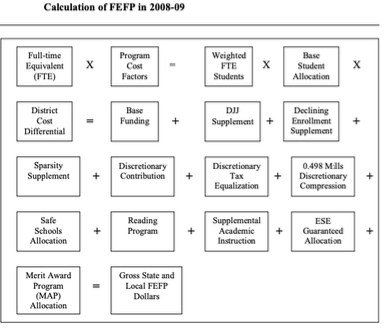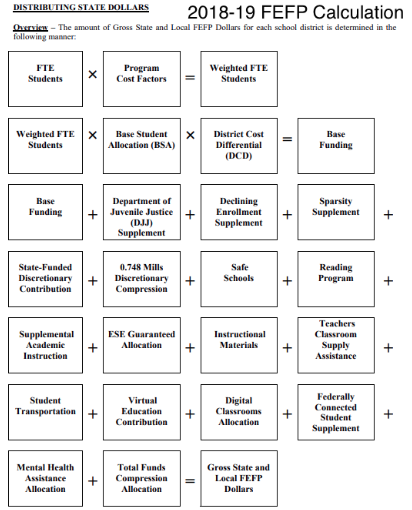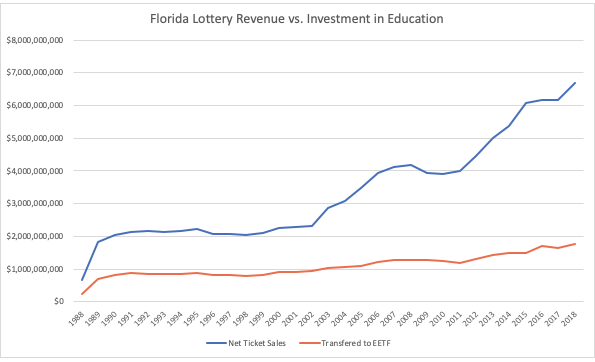By now, almost everyone knows the statistics. Florida’s educators are woefully underpaid – 48th in the nation – and that, in part, has contributed to a massive teacher shortage.
In the first of our series of articles examining the ways that Florida’s politicians are undermining student success, we will take an in-depth look at the issue of teacher salaries — including the history of funding education in Florida and our ideas on what needs to be done.
As we will in every article in this series, we’ll begin by examining the direct impact that Florida’s bad policy has had on students.
Why Low Pay Matters to Students and Parents
First and foremost, students will learn best when they have a certified, experienced teacher to work with them to help them learn and grow. In far too many of Florida’s classrooms, however, students are met with a rotation of substitutes who may or may not have the content knowledge and classroom management skills to teach effectively.
At the start of each recent school year, there are still thousands of vacancies statewide. This translates to hundreds of thousands of students who will start this school year without a certified teacher. History tells us that many of these students will see a churning cast of substitutes throughout the year. The lack of continuity and the lack of a certified teacher in every subject is detrimental to student learning.
Florida’s teacher shortage is directly linked to low pay; there are many wonderful, dedicated and certified teachers who walk away from the profession every year for no reason other than they cannot afford to live in the community where they teach. A survey from Phi Delta Kappan shows that half of all teachers nationwide have seriously considered leaving the profession.
While Florida’s lawmakers seem to be perfectly fine with state budgets that consistently undermine the teaching profession, the harm they have inflicted on Florida’s students as a result of their decisions should have every parent in the state up in arms.
A Brief History Lesson
The low pay Florida’s teachers are currently suffering through is the result of deliberate choices made by Tallahassee politicians. Political agendas that have focused on flawed bonus schemes and performance pay, expanding school choice, and consolidating power at the state level while usurping local control have each played a factor in Florida’s decline in pay relative to the rest of the nation.
As recently as the 2006-07 school year, Florida’s teachers were 28th in the nation in average salary. While being in the bottom half of all the states is nothing to be proud of, Florida has fallen 20 spots since then.
It might be easy for Florida’s lawmakers to blame the bottoming out of Florida’s teacher salaries on the Great Recession, but that excuse doesn’t really hold water for a couple of reasons. First, the entire country suffered during the recession – and Florida’s salaries have dropped not just relative to what they used to be when adjusted for inflation but also relative to the rest of the country.
Bonus and Merit Pay
Something else happened in the mid-2000s other than the Great Recession – the Legislature became obsessed with “rewarding” teachers for their performance. In the past 13 years there have been six different failed bonus programs:
- E-Comp (2006)
- Special Teachers are Rewarded (STAR), (2007)
- Merit Award Program (2008-12),
- Best and Brightest Version I (2015-17)
- Best and Brightest Version II (2017-19)
- Best and Brightest Version III (2019-20)
In total, more than $1.36 billion has been allocated to these programs. Nobody can argue this is money well spent. Every one of these bonuses was touted by the lawmakers who voted for them as a way to reward Florida’s teachers, to retain the very best teachers, and to recruit the brightest minds into the classroom. After 13 years, it is safe to say the bonuses have utterly failed at those purposes. The “reward” teachers have received during this era of bonus pay is moving from the middle of the pack in the national average ranking of pay to the bottom. We must remember it’s not just the teachers who suffer; it’s the 300,000+ students who started school this year without a certified teacher that truly suffer. Florida’s students are the victims of these failed $1 billion experiments.
Related to the failed bonus schemes are the salary requirements included in the first bill Gov. Rick Scott signed into law, Senate Bill 736. This law required teacher salary increases to be tied to performance evaluations. The idea of “merit pay” might sound harmless enough; after all, for the most recent school year 98.5 percent of all teachers were rated effective or highly effective. However, by usurping local control in how raises are given, this state mandate became one of the contributing factors to compression of teacher salary schedules statewide.
Since increases must be the same dollar amount for teachers earning the same rating, teachers who have more experience can see a much smaller percentage increase than their more newly hired peers. Consider this example from Brevard County—a teacher with 22 years of experience makes $51,000. A decade ago, a Brevard County teacher with the same years of experience would have made $57,000. This is a $6,000 decrease without accounting for inflation. When adjusted for inflation, the decrease is over $14,000.
Legislators at the state level are quick to shirk their responsibility; they will remind teachers and the public that salaries are negotiated between the school board and the local union. While that is true, it ignores the reality that Senate Bill 736 placed significant restrictions on how salary increases can be negotiated. Between failed bonus schemes and merit pay, the failure of school districts to provide adequate salaries to their teachers falls squarely at the feet of the Florida Legislature.
Balancing the State Budget on the Backs of Students and Educators
The Great Recession was painful for all Floridians, but the impacts of the recession fell especially hard on Florida’s students. Throughout the state school districts made hard decisions such as cutting music, art, and physical education classes. Students went to schools with fewer teachers’ aides, paraprofessionals, and counselors who lost their jobs due to budget cuts. There is no other way to put it: The Florida Legislature balanced the state’s budget on the back of its students and educators.
In 2013, Governor Rick Scott acknowledged the financial burden placed on Florida’s schools when he told a joint session of the Florida House and Senate, “Four years ago, I stood before you and said we would have to make some hard decisions. And we did. We made reductions that dipped into education, knowing that when the economy improved we could invest again.” The unfortunate reality is students and educators are still waiting to see those promised investments. When adjusted for inflation, per-pupil PreK-12 spending remains almost $1,000 behind pre-recession levels.
One of the ways that the Legislature “dipped into education” in 2011 was with Senate Bill 2100 which imposed a 3 percent tax on public employees in the form a mandatory contribution to the Florida Retirement System. Andy Ford, who was then president of FEA, described the bill this way, “This pay cut was used by legislative leadership to make up a budget shortfall on the backs of teachers, law-enforcement officers, firefighters and other state workers. It is essentially an income tax levied on workers belonging to the Florida Retirement System.”
Florida’s economy rebounded significantly since the Great Recession; we have the 17th largest economy in the world. While the Legislature was quick to balance their budget on the back of public employees, they have so far refused to share Florida’s prosperity with those same employees or the students they serve.
Erosion of Local Control
Come election season, there are few things that politicians love more than local control. However, once they make it to Tallahassee, many change their tune and substitute their own judgement for that of locally elected officials such as school boards.
In Florida statutes there is a bewildering maze of prescriptions and prohibitions for paying teachers including nearly 15 different ways the state directs the school district to determine teacher compensation.
As was explained above, there is a statutory patchwork of transient bonuses with complicated formula and criteria that cannot be adjusted to meet the needs of school districts as varied as Franklin County with its single K-12 school and Miami Dade, the fifth largest school district in the country. This maze of conflicting regulations hurts our children’s schools.
Perhaps the best illustration of Tallahassee’s power grab of local control comes from looking at how the Florida Education Finance Program (FEFP) has changed over the years. In figures 1 and 2 below, you’ll see a graphic representation of the FEFP from 2008-09 and one decade later, in 2018-19.


The first thing you’ll notice that the most recent FEFP has a lot more boxes than it did a decade ago. Each box represents a “categorical,” monies that can only be spent for that specific purpose. In 2018-19 each school district received a set amount of funding, for instance, that could only be spent on “Digital Classrooms Allocation.”
Legislators bragged about their “historic” funding and $100 increase per student in 2018-19. While it is true that overall funding was increased by roughly $100 per student in 2018, by placing virtually all of the increase in categoricals, the state dictated how $99.53 of the $100 would be spent. A mere $0.47 – the price of a postage stamp – was the increase to the Base Student Allocation that funds employee salaries and benefits.
By drastically increasing the number of categoricals over the past decade, the Legislature has taken greater and greater control over how school districts spend their money. When adjusted for inflation, the 2019-20 Base Student Allocation is $143 less than it was in 2008-09. Again, that is $143 less in funding for every single student that can be used for salaries and benefits.
We’ll say it again: When the Legislature places the blame of stagnant and declining wages at the feet of local school boards, they are being disingenuous at best. There can be no doubt that the Tallahassee power grab of local control from school districts is responsible for much of the damage.
Three Parallel Systems
Perhaps the only thing candidates like to talk about more than “local control” is how they will run government like a business. You’ll see that’s a lie, too.
Florida’s Constitution is quite clear that is the Legislature’s “paramount duty” to “adequately fund a uniform, efficient, safe and secure” system of public schools. In addition to neighborhood public schools, Florida also funds private schools and charter schools. There is nothing uniform nor efficient about running three separate school systems, but that is exactly what the Florida’s legislators have mandated. No business would be run this way.
Florida’s taxpayers fund unaccountable private and religious schools to the tune of almost $1 billion annually. These schools, which discriminate in their admission and employment practices, actually must be advertised by school districts on their websites as a result of Senate Bill 7070. It’s not just that politicians have created parallel systems, they are forcing public schools to actively promote the other systems. There is, of course, no requirement that failing private schools like Winners Primary School in Orlando that accept vouchers inform their parents of the better education their child can get for free from their neighborhood public school.
Historically, these schools have been funded through “tax-credit” voucher schemes, but starting this school year, vouchers actually will be funded directly from the FEFP—draining much-needed resources from our neighborhood public schools.
Jeb Bush famously celebrated the opening of Liberty City Charter school in Miami in 1996; it was the first charter school in the state. Students no longer attend Liberty City Charter; it closed about a decade after it opened. In Rick Scott’s first address as governor to a joint session of the Florida House and Senate, he touted the success of Florida International Academy and had the principal of the school attend the speech as one of his guests. Students no longer attend Florida International Academy. It closed, too.
Stories like these are far too common. In fact, more than 400 charter schools have closed since Liberty City first opened its doors. In 2019, there were 657 charter schools operating in Florida. To put it another way, of the 1,065 charter schools that have opened in Florida since 1996, a full 38 percent of them closed by 2019.
School Choice advocates will point to that number as a success – it shows that charter schools are held accountable and the bad ones close. But that is a pretty callous view. When schools close, students and communities are disrupted; in the case of charter schools it is not unusual for this disruption to take place in the middle of the school year or even after just a few weeks, as detailed here. Far from being a success, this is clear evidence of the failure to provide a high-quality, uniform and efficient public education.
There is enough money to pay all of Florida’s educators a salary that allows them to work only one job. There is enough money to invest in decent benefits and retirement for all of Florida’s educators. But, each year well over a billion dollars is siphoned off to parallel systems of education without the same standards or accountability as public schools. So, once again when legislators say they are not to blame for low pay and benefits, it’s worth remembering they control the state budget. They could stop diverting money away from public schools any time they want.
A Path Forward: Putting Students’ Needs First
Recovering from a decade of neglect will not be easy and will likely not happen overnight, but with several years of serious investment in Florida’s future our legislators can and must ensure that Florida’s teachers are among the highest paid in the country instead of the lowest. Only then will Florida be able to recruit and retain enough teachers to end the teacher shortage and to ensure that every student has the highly-effective teacher they deserve.
We’ll provide several specific steps that can be taken to ensure that happens.
1. Repurpose “Bonus” Funds for Salary Enhancements
As was documented above, Florida has poured well over $1 billon into schemes to recruit and retain educators and has nothing to show for it. Commonsense dictates that this practice must stop. For the 2019-20 school year alone, the Legislature allocated $284 million for Best and Brightest bonuses. Placing that money into the Base Student Allocation in 2020-21 allows school boards and local unions to negotiate salary and benefit enhancements with the money. Importantly, this money will be available for all educators. Florida’s focus on funding through bonuses in the past decade has left out pre-kindergarten teachers, school counselors, academic coaches, paraprofessionals, bus drivers, secretarial staff, custodial staff and many more. All Florida’s educators deserve a raise. Repurposing currently existing bonus money is a good start to making that happen.
2. Increase Per Student Funding by 10% in 2020-21
After a decade of neglect for Florida’s public schools, it is time for to begin the decade of progress. Florida’s lawmakers must make a serious down payment in 2020 of $2.4 Billion – a 10% increase in per student funding. While this sounds like a lot of money, it will only move Florida up four spots in national rankings in terms of per-pupil spending.
- This would be $767 more per student – with $614 going to the base student allocation (BSA)
- This would allow for a 10% across the board increase in pay for all public school employees.
- As importantly, this increase would allow for more of the types of services that all of Florida’s students deserve. Schools would have the funds to hire additional school counselors, social workers and psychologists.
- After seeing a decade of cuts to the arts, this increase would allow for more funding for music, art and physical education teachers.
- A 10% increase in pay would move teachers up 10 spots in national rankings and make significant progress for our Educational Staff Professionals, many of whom (nearly 10%) live in poverty.
3. Eliminate Statutory Regulations on Salary Increases
Salary decisions for Escambia County are best made in Escambia. Salary decisions for Monroe County are best made in Monroe. And the same is true for the other 65 counties in-between. But the very first bill Gov. Rick Scott signed into law stripped local pay decisions from counties and forced them to follow burdensome state regulations. It’s worth remembering the promises that were made at the time.
Disgraced former Representative Erik Fresen had this to say:
“This bill will provide for a system that recognizes those highly effective educators and rewards them appropriately.”
Former Senate President Mike Haridopolos remarked,
“[T]he implementation of the Student Success Act will contribute to our competitiveness in attracting individuals to move and stay in our state.”
Former Senator Steven Wise said,
“I believe this bill will attract top-quality educators to Florida.”
Upon the bill’s passage the Florida Senate put out a statement that read in part:
“Florida has no shortage of hardworking, excellent teachers — the state ranks well nationally in terms of education success. However, Florida’s current evaluation system for the teaching profession lacks financial incentives ...”
The state took control of local salary decisions and promised their way would work better. Time has proven them wrong. Almost a decade after the passage of Senate Bill 736, Florida has a serious teacher shortage, and teacher pay is a disgraceful 46th in the nation. Let us be clear: The Legislature’s plan to fix the problem they created by removing local control cannot be to further take away local control. Conversely, by eliminating current regulations imposed onto school districts by the state, Florida’s counties –the laboratories of democracy – can come up with plans that work best for them.
How will Florida Fund this Commitment?
The question of where the funds will come from to cover these proposals is an important one. As has already been mentioned, part of the funding can come from repurposing the funds currently used for bonuses. There is certainly other funding in Florida’s that could be redirected into the classroom as well; let’s remember that Florida currently has a $93 billon budget – the money currently exists to fulfill the constitutional obligation to adequately fund public education.
That being said, we wanted to offer some other solutions as well. For starters, let’s talk about the Florida Lottery. When voters approved the lottery in the late 1980s it was done so with the explicit understanding that the revenue generated from the lottery would be used for education. And for the initial few years, much of the lottery revenue was, in fact, used for education. At its peak in the 1990-91 fiscal year, a full 41% of all lottery revenue was directed into the Educational Enhancement Trust Fund (EETF). However, the laws have changed significantly since then.
In the year 2000 and prior, state statute read, “Each fiscal year, at least 38 percent of the gross revenue from the sale of lottery tickets and other earned revenue, excluding application processing fees, shall be deposited in the Educational Enhancement Trust Fund.” In 2004 the law was changed from 38 percent of the sale of all lottery tickets to “at least 39 percent of the gross revenue from the sale of on-line lottery tickets” The following year, House Bill 841 removed even the 39% requirement for online sales. Anyone who has been paying attention knows what happened next.
For the 2017-18 fiscal year, the most recent year for which there is data, a mere 26% of ticket sales were transferred to the EETF. If the lottery transfers remained at 39%, the EETF would have received an additional $855 million in the last fiscal year and an additional $3.7 billion over the past five years.
Another important aspect of the above chart is the continued, strong growth of lottery funding. Since its inception, the lottery’s revenue as increased, on average, over 10% annually. This means that funding of education through the lottery is actually a sustainable plan. We offer this suggestion with a big note of caution. It is vitally important that any additional funds placed into the EETF are used to supplement current funds not as a substitute for current funding.
You see, soon after the lottery was established, researchers from the University of Florida studied state education funding (you must log-in to JSTOR to view the research) in the early years of the lottery to determine whether the Legislature used the funding to enhance education as the voters directed or to supplant existing education funding.
The researchers examined funding for the 1989-90 school year, a mere three years into the Florida Lottery. They found “approximately 56.8 percent of lottery proceeds was used as a substitute for existing resources.” This was not what the voters of Florida wanted when the approved the lottery via a constitutional amendment in 1986.
Voters have consistently signaled their desire for the state to fund education, from the constitutional amendment that allowed the lottery in 1986 to recent local elections where more than 20 counties –representing more than 50% of Florida’s public school population – voted to increase their own taxes in order to better fund schools. In the 2020 legislative session it is time for our lawmakers and our governor to do the will of the people. It is time to #FundOurFutureFL.
Want more in-depth coverage of the ramifications of two decades of Bad Policy and Low Pay? Check out Part II of our series, which focuses on Florida’s VAM Scam.


